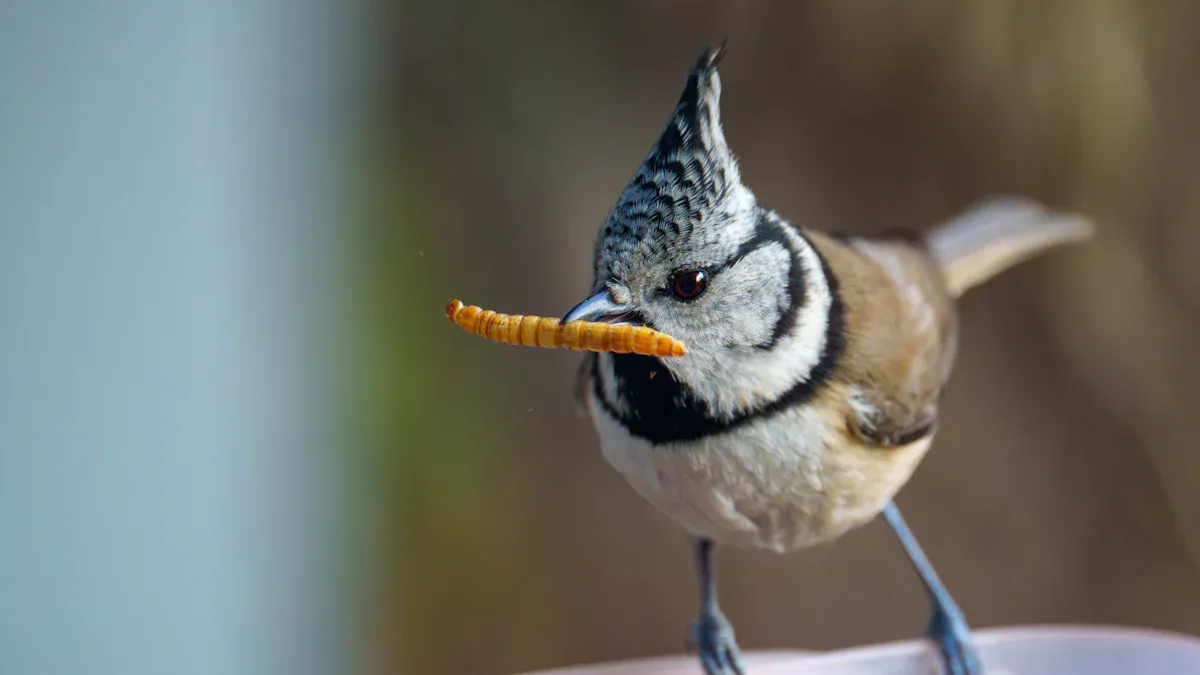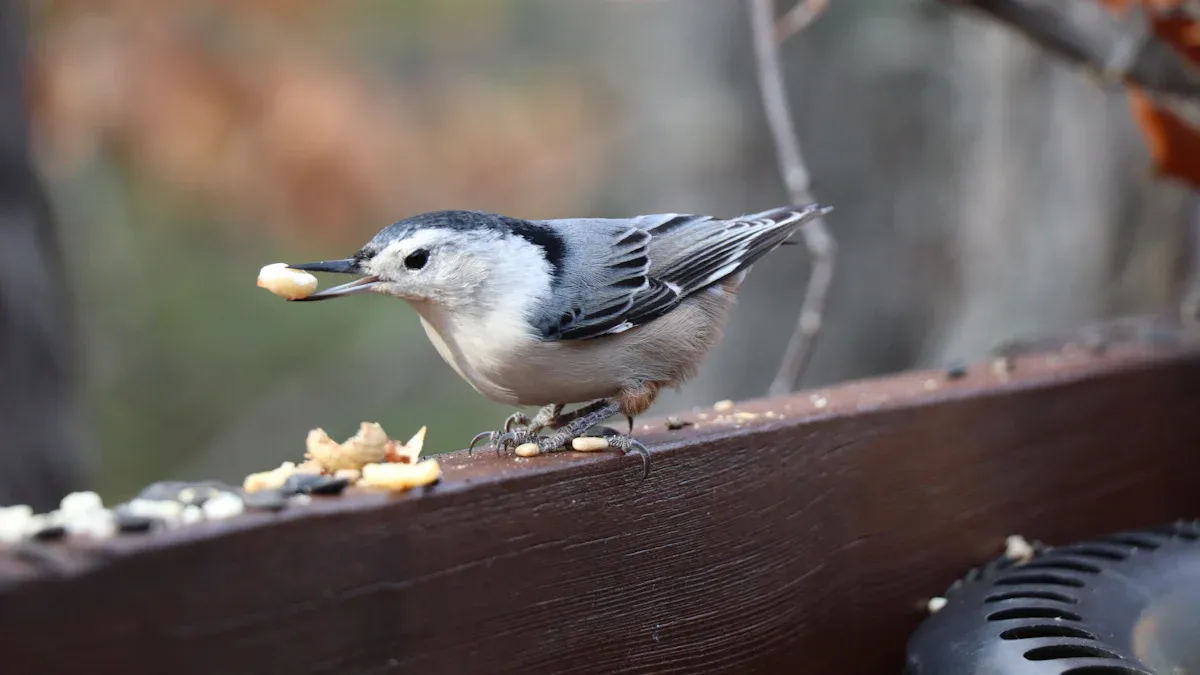
If you’re looking for an easy way to attract more birds to your yard, Dried Mealworms for Bird might be the perfect solution. Packed with protein, healthy fats, and fiber, they’re like a superfood for birds. These nutrients help with muscle growth, feather strength, and energy, especially during breeding seasons. Plus, they’re simple to serve and store, making them a hassle-free option for bird lovers like you.
Key Takeaways
- Dried mealworms are healthy food for birds. They are full of protein and fats, which help birds grow strong and stay active, especially when they are breeding.
- Choosing the right feeder for dried mealworms is important. Pick one with tall sides, a roof to block rain, and holes to drain water. This keeps the mealworms fresh.
- Mixing dried mealworms with seeds or fruit can bring more birds. It also gives birds a balanced diet and makes birdwatching more fun.
How to Use Dried Mealworms for Bird Feeding
Adding Mealworms to Bird Feeders
Using bird feeders is one of the easiest ways to serve dried mealworms for bird feeding. You’ll want to choose a feeder designed to keep the mealworms secure and fresh. Look for features like tall sides to prevent them from spilling, a roof to shield them from rain, and drainage holes to avoid mold. Feeders like the Perky-Pet® Dried Mealworm Bird Feeder are excellent options. They’re built with Flexports® that allow birds to feed naturally while keeping the mealworms in place.
To make the mealworms even more appealing, try soaking them in lukewarm water before placing them in the feeder. This softens them and makes them more enticing, especially for birds that prefer a moist texture. If you’re introducing mealworms for the first time, consider offering live ones briefly to grab the birds’ attention before switching to dried ones.
Mixing Mealworms with Other Bird Food
Combining dried mealworms with other bird food is a smart way to attract a variety of species. It also ensures the birds get a balanced diet. You can mix mealworms with seeds, suet, or even fruit pieces. This combination enhances the nutritional value of the food and encourages more birds to visit your yard.
For example, adding mealworms to a seed mix can draw in insect-eating birds like bluebirds and robins while still appealing to seed-eaters. Soaking the mealworms beforehand can make the mix even more appealing. This approach not only promotes bird health but also creates a lively and diverse birdwatching experience.
Offering Mealworms on Ground Trays or Platforms
If you prefer a more natural feeding method, ground trays or platforms are a great choice. Birds like robins and thrushes, which are ground feeders, will appreciate this setup. Place the tray in an open area to make it easy for birds to spot.
Dried mealworms are especially valuable during winter when food is scarce. Their high protein content helps birds maintain energy and stay warm. Plus, this method often attracts less common species, adding excitement to your birdwatching. By using eco-friendly mealworms, you’re also supporting sustainable wildlife feeding practices.
Benefits of Feeding Birds Dried Mealworms

High Nutritional Value for Birds
Dried mealworms are a powerhouse of nutrition for birds. They’re packed with protein, essential amino acids, and healthy fats, all of which are vital for feather growth, muscle development, and energy. Birds need these nutrients to stay active, especially during breeding and migration seasons.
Tip: Soaking dried mealworms in water can make them more hydrating, which is particularly helpful during hot summer months.
While live mealworms provide hydration, dried mealworms offer higher protein and fat content, making them an excellent energy source. Here’s a quick comparison:
| Nutritional Component | Live Mealworms | Dried Mealworms |
|---|---|---|
| Protein | Lower | Higher |
| Fat | Lower | Higher |
| Hydration | Yes | No |
This makes dried mealworms a wholesome option for most birds, though they’re less suitable for nestlings due to the lack of hydration.
Convenient and Long-Lasting
One of the best things about dried mealworms is how easy they are to store and use. Unlike live mealworms, they don’t require refrigeration or special care. You can keep them in a cool, dry place, and they’ll stay fresh for months.
Their long shelf life means you can always have a reliable food source on hand for your feathered visitors. Plus, they’re less messy than live mealworms, making them a hassle-free choice for bird enthusiasts.
Did you know? Dried mealworms are produced sustainably, which means they have a much lower carbon footprint compared to traditional livestock farming. By choosing them, you’re not just helping birds—you’re also supporting eco-friendly practices.
Encourages Bird Activity and Diversity
Adding dried mealworms to your bird feeding routine can transform your yard into a lively hub of activity. Birds love the high energy they provide, which keeps them active and healthy. Species like bluebirds, robins, and wrens are especially drawn to this protein-rich treat.
Dried mealworms also attract a diverse range of birds, from insect-eaters to omnivores. This variety makes birdwatching more exciting and helps maintain ecological balance. Since different species forage differently, there’s minimal competition, allowing more birds to thrive in your yard.
By offering dried mealworms, you’re not just feeding birds—you’re creating a vibrant, sustainable ecosystem right in your backyard.
How to Prepare and Serve Dried Mealworms
Rehydrating Mealworms for Better Palatability
Rehydrating dried mealworms is a simple way to make them more appealing to birds. All you need is a bowl of water and about 30 minutes to an hour. Place the mealworms in the water and let them soak until they absorb enough moisture to return to a softer, more natural state. Once they’re ready, drain any excess water before serving them to your feathered visitors.
This process not only makes the mealworms easier for birds to eat but also provides hydration, which is especially important during hot or dry weather. Birds like robins and bluebirds are more likely to flock to your yard when you offer rehydrated mealworms. It’s a small step that can make a big difference in attracting a variety of species.
Serving Mealworms Dry for Convenience
If you’re looking for a no-fuss option, serving dried mealworms as they are is a great choice. They’re easy to handle, store, and serve, making them perfect for busy bird enthusiasts. Simply place them in a feeder, mix them with other bird food, or scatter them on a platform.
While some birds prefer live or rehydrated mealworms, many species will happily snack on dried ones. This method is also cost-effective and less messy, making it a practical option for everyday feeding.
Storing Mealworms Properly to Maintain Quality
Proper storage is key to keeping your dried mealworms fresh and nutritious. Store them in a cool, dry place, ideally at a temperature between 40-50°F (4-10°C). Use a container with small holes or a mesh lid to allow airflow and prevent moisture buildup.
Regularly check for signs of mold or contamination to ensure the mealworms remain safe for birds. Keeping them sealed in their original bag can also help extend their shelf life. With these simple steps, you’ll always have a high-quality food source ready for your feathered friends.
Birds That Love Dried Mealworms
Common Backyard Birds Attracted to Mealworms
Dried mealworms are a favorite snack for many backyard birds. You’ll often see species like bluebirds, robins, chickadees, and cardinals flocking to your yard when you offer these protein-packed treats. Bluebirds, in particular, are big fans of mealworms, whether they’re served dry or soaked. Chickadees and robins also enjoy them, making mealworms a versatile choice for attracting a variety of birds.
If you’re just starting out, try placing mealworms in a feeder or scattering them on a platform. Birds like Carolina wrens might take a little time to notice, but once they do, they’ll keep coming back. Adding mealworms to your bird feeding routine is a simple way to bring more feathered friends to your yard.
Seasonal Birds That Benefit from Mealworms
Some birds benefit from dried mealworms more during certain times of the year. For example, cardinals, nuthatches, and chickadees rely on them in winter and spring when natural food sources are scarce. In spring and summer, species like orioles, bluebirds, and scarlet tanagers enjoy mealworms as they prepare for breeding or migration.
Here’s a quick look at which birds benefit most by season:
| Bird Species | Season(s) Benefiting |
|---|---|
| Cardinals | Winter, Spring |
| Nuthatches | Winter, Spring |
| Chickadees | Winter, Spring |
| Woodpeckers | Winter, Spring |
| Rose-breasted Grosbeaks | Spring, Summer |
| Orioles | Spring, Summer |
| Bluebirds | Spring, Summer |
| Scarlet Tanagers | Spring, Summer |
Offering mealworms year-round ensures you’re supporting birds through their toughest seasons.
Supporting Nesting and Migratory Birds with Mealworms
Mealworms are a fantastic energy source for nesting and migratory birds. They’re rich in protein and fats, which are essential for muscle development and overall health. During the breeding season, birds need extra energy to feed their young, and mealworms provide the perfect boost.
Tip: While dried mealworms are great for adult birds, they can dehydrate nestlings. If you’re feeding nesting birds, consider soaking the mealworms first or offering live ones for added hydration.
Migratory birds also benefit from mealworms as they prepare for long journeys. The concentrated nutrients help them build strength and stamina, ensuring they’re ready for the challenges ahead. By offering mealworms, you’re giving these birds the support they need to thrive.
Tips for Using Dried Mealworms Effectively
Choosing the Right Feeder for Mealworms
Selecting the right feeder can make a big difference in how effectively you serve dried mealworms. Look for feeders designed specifically for mealworms to prevent spillage and keep them fresh. Here are some key features to consider:
| Key Feature | Description |
|---|---|
| Tall sides | Prevents mealworms from crawling out. |
| Roof or baffle | Shields mealworms from rain, avoiding mold or sogginess. |
| Drainage holes | Allows water to escape, keeping mealworms dry and safe. |
| Tamper-resistant design | Discourages squirrels and other pests from stealing the mealworms. |
Once you’ve chosen the right feeder, hang it in a visible spot, away from predators. This setup ensures birds feel safe while enjoying their mealworms.
Combining Mealworms with Other Bird Food
Mixing dried mealworms with other bird food is a great way to attract a variety of species. You can combine them with seeds, suet, or even fruit pieces. This not only enhances the nutritional value but also appeals to both insect-eating and seed-eating birds.
For example, adding mealworms to a seed mix can draw in bluebirds and robins while still attracting chickadees and cardinals. If birds seem hesitant, try moistening the mealworms slightly to make them more appealing. Once one bird starts eating, others will follow.
Adjusting Mealworm Quantities Based on Bird Activity
Pay attention to how much your birds eat. During nesting season, robins may take 10 to 15 mealworms at a time for their young. In such cases, reduce the quantity to avoid overfeeding. Dried mealworms can dehydrate nestlings, so it’s best to soak them or limit their use during this time.
If birds aren’t eating the mealworms quickly, adjust the amount you offer. Start small and increase as needed. This prevents waste and ensures the mealworms stay fresh.
Dried Mealworms for Bird feeding offer a simple way to enhance your backyard birdwatching experience. They’re packed with protein and healthy fats, making them a nutritious treat for a wide variety of birds like chickadees, bluebirds, and robins. Plus, they’re eco-friendly, easy to store, and cost-effective compared to live mealworms.
By incorporating mealworms into your bird feeding routine, you’ll attract more species, including less common ones, while supporting their health year-round. Whether you mix them with seeds or serve them on their own, mealworms create a lively and diverse bird habitat. Start today and enjoy the beauty of nature right in your backyard!
FAQ
How do I attract birds to dried mealworms if they seem uninterested?
Start by soaking the mealworms in water to soften them. Birds often prefer moist food. You can also mix them with seeds or fruit.
Can I feed dried mealworms to baby birds?
Avoid feeding dry mealworms to nestlings. Soak them in water first to provide hydration. Live mealworms are another great option for feeding baby birds.
How much should I feed birds daily?
Offer small amounts at first and observe bird activity. Adjust the quantity based on how quickly they eat. Avoid overfeeding to prevent waste or spoilage.


